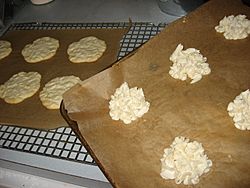Jumble (cookie) facts for kids

Buttermilk jumbles
|
|
| Alternative names | Jumballs, Jambles, jingles, jumbals, jumbolls, jumbolds, jumballs, dimples, jumblins', jambal, gimples, jimples, sugar-bundles, gongles, jemelloe, gemmel, jungles, butter-bumbles |
|---|---|
| Type | Cookie |
| Main ingredients | Flour, eggs, sugar, butter |
| Variations | Almond, coconut, nutmeg |
Jumbles are a type of simple butter cookie. They are made with a basic recipe. This recipe includes flour, sugar, eggs, and butter.
You can add different flavors to jumbles. Some common flavors are vanilla, anise, or caraway seeds. Almond is another popular flavor. In the past, jumbles were often shaped like rings or rolls.
Jumbles were very popular because they were great for travel. They were very dense and hard. This meant they could be stored for up to a year. They wouldn't get too stale. Because they were so dense, people sometimes twisted them into knots before baking. This made them easier to eat. That's why "knots" was another common name for them.
Contents
What are Jumbles?
Jumbles were traditionally shaped in fancy loops or knot patterns. These shapes were usually made from rolled-out dough. Early flavors included aniseed, coriander, caraway seeds, and rosewater. Later, especially in the United States, "jumbles" meant a thin, crispy cookie. These often used lemon peel for flavor.
Jumbles vs. Cookies
Jumbles and cookies are very similar. Sometimes, a jumble might even be called a cookie. But "cookie" is a wider term. It means any small, flat cake. This includes both soft and crispy ones. Jumbles, however, are usually the crispy kind.
A recipe from 1907 described jumbles as "crisp like snaps." It said the dough should be rolled out so thin. You could almost see through it. The recipe used very little liquid. Just creamed butter and a small amount of milk. Enough to make a stiff dough, like pie crust.
A Look at Jumbles Through History
We know of a recipe for "Almond Jumballs" from 1694. To make them, people mixed ground almonds with orange flower water or rose water. Then they added sugar syrup, dry sugar, and egg whites. These ingredients were pounded into a paste. They could be colored with chocolate or cochineal. People brushed them with lemon juice or rose water for more flavor. They were baked very gently. The recipe warned to set them on something so they wouldn't touch the bottom of the oven.
Jumbles were common in Europe by the 1600s. They might have started in Italy as the cimabetta. They were a very common cookie for travelers. They were likely brought to America on the Mayflower. Or maybe even earlier, to Jamestown. There's even a famous recipe for this cookie. It is said to be from Martha Washington.
An 18th-century recipe from The Compleat Housewife shows how they were made. Three egg whites were beaten with milk, flour, sugar, and caraway seeds. This made a stiff paste. They could be made in any shape. Then they were baked on baking parchment.
Originally, jumbles were twisted into different pretzel-like shapes. Then they were boiled. By the late 1700s, jumbles became rolled cookies that were baked. This made a cookie very similar to a modern sugar cookie. But they didn't use leavening agents like baking powder back then.
Cookbooks from the Victorian era have many jumble recipes. They added things like candied fruits, coconut, lemon, and other flavors.
How Jumbles are Made
To make jumbles, first, butter and sugar are creamed together. This means mixing them until they are light and fluffy. Then, eggs or egg yolks are added. Sometimes milk is added too, depending on the recipe. After that, the dry ingredients go in. These include flour and other things like grated coconut, flavor extracts, and spices. Spices like cloves, cinnamon, or allspice can be used.
Sometimes, baking soda or baking powder is added. Raisins can also be included. In some recipes, the egg whites are whipped until they are foamy. Then they are added separately after the dry ingredients. The cookie dough can be rolled in sugar or cinnamon before baking. There are many different ways to make jumbles. Some types are sugar jumbles, coconut jumbles, cinnamon jumbles, and fruit jumbles (also called hermits). A 1907 recipe for "cocoanut jumbles" used one part butter to three parts sugar.
The Word "Jumble"
The word "jumble" comes from the French word jumelle. This word means "twin". It likely refers to the twisted or paired shapes of the cookies.


